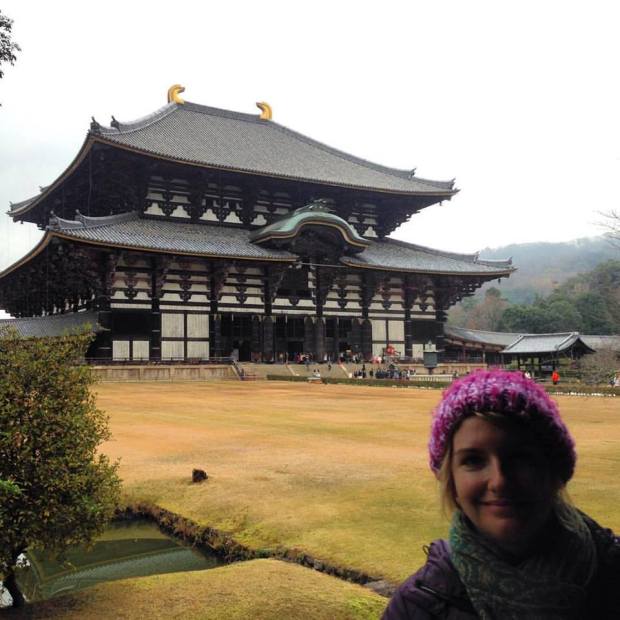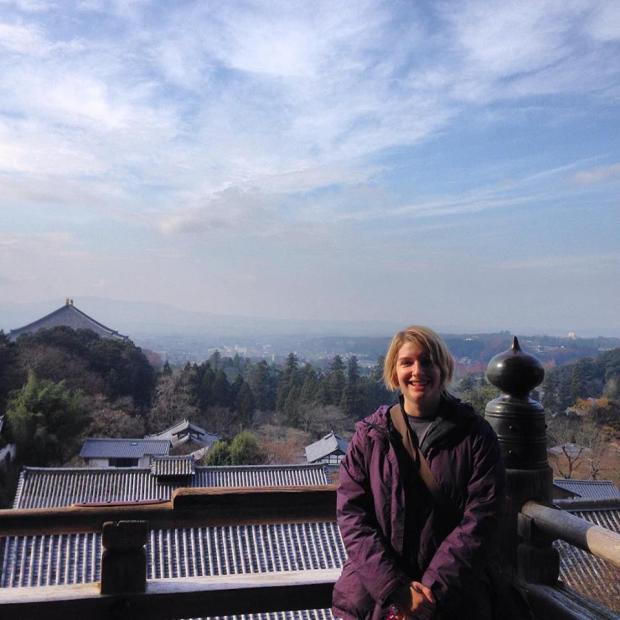After enjoying the vibrant, electronic and wild Tokyo vibe, we took our first Shinkansen (Japanese bullet train) to Nara, via Kyoto. The Japanese bullet trains are one of the most comfortable methods of travel that I can imagine. The Japan Rail employees were all extremely helpful, even with limited English. We stocked up on Lawson sandwiches (a true Japanese delight, purchased from the equivalent of a gas station), and enjoyed the scenic ride through the Japan countryside.
We arrive in Nara and found our quaint hotel called Guesthouse Iki. This was a very small guesthouse ran entirely by the owner. We slept on the floor, on tatami mats, but did have our own bathroom. A private bathroom was a luxury that we would not have for much of our trip, but more on that later. Using the ever helpful TripAdvisor, Angela located a nearby sake brewery once we had settled into our guesthouse. We wandered through the rustic lanes of Nara to find the Harushika sake brewery. For 500 yen, which is about $5 USD, we were given six shots of sake and a souvenir sake glass. I thought this was a steal, and the sake was very good. We had a dry sake, strawberry sake (little weird), unfiltered sake, a cloudy and fizzy sake, and lastly sparkling sake. We had yet to find dinner, and Angela is not much of a sake fan, so I ended up with far more than 6 helpings and was feeling desperately ready for some food.
We headed to the Nara Deer Park for our first full day in the old capital. This is a magical place. Before Nara, the capital would be moved every time the emperor died. I suppose it had something to do with ‘bad luck’, but obviously this was not a sustainable practice in such a small country, so Nara was the first permanent capital. The Nara Deer Park contains a bunch of the fascinating historical gardens, buildings and temples in the area. The Deer Park also contains something that might not be obvious to the reader based upon it’s mysterious name. The Deer Park has loads of deer that have been all but domesticated over time with free handouts.
Our first objective in the Nara Deer Park was to complete the Lonely Planet’s walking tour of the area. I love walking tours. They are free (with the option of paying some entrance fees) and a good way to see an area if you are not sure where to start. Our walking tour led us to begin at Isuien Garden. This is a beautiful traditional Japanese garden. At the start, we were greeted by an older man who offered to be our free tour guide. His English was fairly good, and he explained every detail of the garden, and then let us wander through and enjoy the garden’s serenity.
The next stop on our walking tour was Nara’s Great Buddha. The most impressive thing about the Great Buddha (in my opinion) is the building in which it is housed. According to Lonely Planet, it was the largest wooden building in the world until recently.
My favorite part of the historical Nara Deer Park was the deer. Upon entering the park, we were warned that the deer could become aggressive.
I never saw any humans get attacked by deer, but I did witness my fair share of deer fights which was equally exciting. I also enjoyed watching the deer observe the local custom of bowing to people that had food. Angela and I both tried to coerce deer into bowing to us, with limited success.
The deer park is quite a large area, with many temples and lookouts located throughout. It is a great way to spend a day, with few entrance fees. Buying deer food is optional.
After our day exploring the Nara Deer Park, we went for okonomiyaki. This is a pizza-like meal, but not really in taste or texture. It is very good, and we found a great place for it that I can no longer remember. After that, we decide to check out one of Japan’s themed cafes – an owl cafe!
I am not sure what I was expecting, but this was actually a pretty depressing experience. The owls were all chained up, and though there were rules to keep the owls safe, they were still chained up. They had a great horned owl that nobody was allowed to go near, because they had just received it and, as might be expected, was angry and aggressive. I felt bad for having participated, but not before we took a couple of photos.
We spent the rest of our time in Nara catching up on some laundry, and enjoying a nearby arcade that had free ‘Street Fighter’ machines. I think that we both felt that we spent too much time in Nara, as we ran through the list of things to do fairly quickly. It is a nice city, but I would recommend to anyone traveling there to spring for a nice hotel/Ryokan option in Nara, and go for the cheaper accommodations in the busier cities.











Jason & Angela,
Thanks so much for sharing.
Gary Griffin